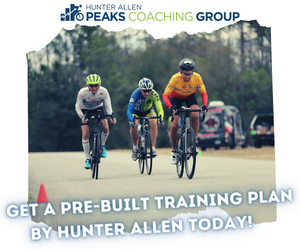Bicycle Racing News and Opinion,
Wednesday,
April 20, 2016
Bicycle Racing News and Opinion,
Wednesday,
April 20, 2016
Back to news and opinion index page for links to archived stories | Commentary
Things may come to those who wait, but only the things left by those who hustle. - Abraham Lincoln
Recently completed racing:
- April 15 - 17: Vuelta a Castilla y Leon
- April 17: Amstel Gold Race
- April 17: Tro-Bro Léon
- April 17: Giro dell'Appennino
Current racing:
- April 19- 22: Giro del Trentino
- April 20: La Flèche Wallonne
Upcoming racing:
- April 24: Liège-Bastogne-Liège
- April 24 - May 1: Presidential Cycling Tour of Turkey
Team Sky suspends Sergio Henao over biological passport
In response to the Cycling Anti-Doping Foundation's request for more information about Sergio Henao, Team Sky has voluntarily removed Sergio Henao from racing for three months. Henao was scheduled to start today's Flèche Wallonne as a favorite for victory, but he is not riding the Belgian classic.
This is the second time the team has suspended Henao. In 2014 it was because the team had its own questions about his out-of-competition numbers.
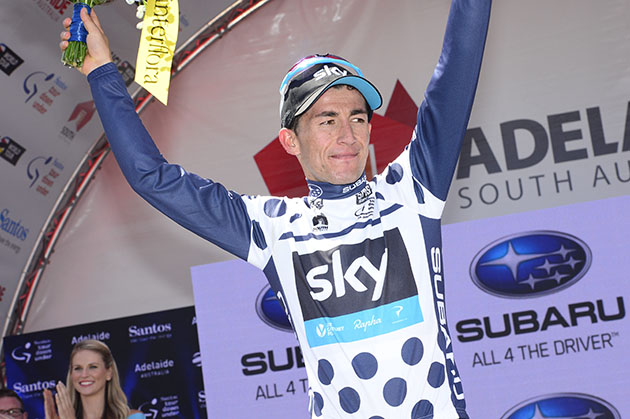
Sergio Henao earlier this year at the Tour Down Under
Here's is Team Sky's statement, in full, unedited:
In March 2014, Team Sky took the tough decision to withdraw Sergio Henao from racing for a period of three months.
As we announced at the time, this was as a result of the team's own internal monitoring of Athlete Biological Passports and in response to Sergio's initial out-of-competition control tests at altitude in Colombia. These tests were introduced that winter by the anti-doping authorities.
Sergio was born in Colombia and raised in the mountains. He goes back to Colombia during the winter and lives and trains at different altitude levels. The team's understanding of the effects of such prolonged periods at altitude after returning from sea level has been limited by a lack of scientific research into 'altitude natives' such as Sergio.
At the time, Team Sky made this issue public and drew it to the attention of the relevant authorities - the UCI and Cycling Anti-Doping Foundation (CADF) - and asked them for assistance. To aid our understanding of Sergio's readings, we then commissioned a 10-week research programme led by Dr Eddie Hampton, a consultant haematologist from the University of Sheffield, with other independent scientific experts. This programme involved further randomised blood and urine tests at sea level and altitude, undertaken through WADA accredited laboratories.
After completing their research, the experts had the highest level of confidence that the readings which prompted us to undertake further testing were the athlete's normal response to altitude. As a result, Sergio returned to racing with Team Sky in June 2014.
Sergio has this week been contacted by the CADF with a request for more information with regards to readings on his Athlete Blood Passport between August 2011 to June 2015. These include the same readings which prompted us to undertake further research in 2014. Given the team had drawn the attention of anti-doping authorities to the issue at the time, this does not come as a surprise.
Sergio has not failed a drug test and the CADF process is conducted confidentially. However, given that we have raised this issue in the past, we feel it is important to set out our latest position.
We continue to support Sergio and remain confident in the independent scientific research which was undertaken. We will be helping Sergio make his case robustly over the coming period. He will also withdraw from racing until the issue is resolved given this contact from the CADF and the very obvious distraction to him. There is no obligation on us to do this but it is team policy if and when a formal process such as this begins.
We do have to recognise the CADF process going forward so we hope people understand why we will be unable to give further commentary on it over the coming weeks. It is our hope that this can be looked at and resolved quickly by all the relevant authorities so Sergio can start racing again soon.
Sir Dave Brailsford said:
"The physiology of 'altitude natives' is a complex area. The science is limited and in recent years we have proactively sought to understand it better by undertaking detailed scientific research - both for Sergio and for the benefit of clean sport more widely. We recognise why the CADF have raised this issue as it is one we have obviously raised ourselves. Thus far Sergio's data has been anonymous to the CADF experts. We hope and believe they will reach the same conclusions when they consider the background and all the evidence over the coming weeks.
"We believe in Sergio. He has just come back to full fitness after spending eight months recovering from a potentially career ending crash. But we respect the CADF process and will apply our team policy in the circumstances.
"We will continue to support him fully during this period so he can get back to racing as soon as possible."
Sergio Henao said:
"I am beyond disappointed. I have worked incredibly hard to get back to racing fitness after shattering my knee last year - but I know who I am, how hard I have worked and the sacrifices I have made to be where I am today.
"I am calm and confident that this will be resolved soon so I can get back to racing as soon as possible."
La Flèche Wallonne team race previews
This release came from Tinkoff:

Starting in Marche-en-Famenne, the second of the Ardennes Classics, the racing moves from the Netherlands to Belgium for La Flèche Wallonne on Wednesday. Fresh from a strong start to Ardennes races, where Michael Valgren finished second in the Amstel Gold Race, taking his first podium position in a UCI WorldTour race, the team will face a challenging course that finishes on the infamous Mur de Huy climb.
The 80th edition of La Flèche Wallonne has only six climbs, however these are repeated multiple times over the race’s 196km distance. After 59.5km of racing, the route passes through the village of Ohey where the circuit covers the key climbs of the race. These first 59km of racing are far from flat, however, crossing an undulating parcours, but it is in the final 137km that the climbs take on a different character.
“Like Amstel Gold on Sunday we come into Flèche Wallone looking to protect Roman Kreuziger and Michael Valgren, bringing them into the final in a good position ahead of the final climb up the Mur de Huy,” explained Sport Director Bruno Cenghialta.
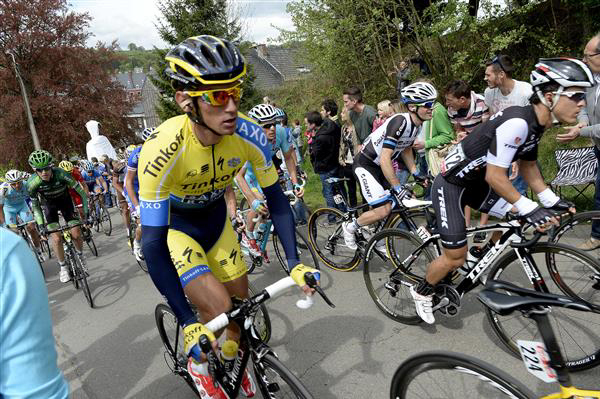
Roman Kreuziger
“Wednesday is another difficult race, with high speeds and tough climbs including three ascents of the Mur. You have to save what energy you can throughout the day and stay out of trouble before then being well positioned at the end, so like the other classics positioning is important here. After a hard race you usually see a reduced bunch of 40 or 50 going into the final climb together, and here you also have to be at the front.”
All such races have their iconic climbs, and just as the Amstel Gold Race has the Cauberg, La Flèche Wallonne has the Mur de Huy. This is one of the iconic climbs, not just of the Ardennes Classics, but of professional cycling itself. 1.3km in length and with an average gradient of 9.3%, the climb’s maximum gradient is an incredible 26%. The race climbs the Mur de Huy three times, with the third time being to the race’s finish, but the other two occasions will sap riders’ energy, making the race all the more difficult. The race will likely be decided on this climb.
While the Mur de Huy is one of the most iconic, the remaining climbs are tough, and are not to be overlooked. The Côte de Bellaire, which the race climbs at 67km and 133km, has an average gradient of 6.3%, while similarly, the Côte de Bohissau, which is climbed for the first time after 74km, and again at 140km, and over 1.3km, climbs at an average gradient of 7.6%.
The penultimate climb of the race, the Côte de Cherave, comes at the 190.5km point. Introduced for last year’s edition of the race, the climb has an average gradient of 8.1% over its 1.3km length. While a tough climb in itself, it comes just a few kilometres before the race’s final ascent of the Mur de Huy and after nearly a day in the saddle. After a technical start on a paved approach road, the climb is consistently hard, with little chance for recovery. As a new addition to the race, teams may look to capitalise on the climb having raced it once before – the climb was welcomed by riders in last year’s race due to it forcing teams to shift their strategies compared to previous years.
Tinkoff will be led by Roman Kreuziger on Wednesday, and will be joined by Michael Valgren, fresh from his second place in the Netherlands at the Amstel Gold Race. Roman has performed well in the race in the past, having finished eleventh in last year’s edition of the race and eighth in 2014.
“Michael showed his strength in a race like this in Amstel and he can take his opportunities ahead of the tough final. Roman was also strong and has the experience to help guide the team. We will look after both of them as well as looking at the opportunities for going in the early breakaway in case that will take some pressure off the guys behind. I think that we can get another nice result here.”
Also at the start in Marche-en-Famenne will be Pavel Brutt, Robert Kiserlovski, Evgeny Petrov, Pawel Poljanski, Ivan Rovny and Yuri Trofimov. The race will be worth watching for the final climb of the iconic Mur de Huy alone, but with a strong team and strong performances in the season so far, this is certain to be an exciting race.
Here's Lotto-Soudal's Flèche Wallonne preview:
The peloton returns to Belgium this week, after spending a few days in the south of Holland, to ride the two final Spring Classics of the season. Starting with La Flèche Wallonne, the second of three Ardennes Classics, which is scheduled on Wednesday 20 April 2016. The course is slightly different compared to last year, the riders need to cover about 200 kilometres and they need to surmount twelve hills.
Sports director Herman Frison: “The course is a bit different compared to previous years indeed. The riders start in Marche-en-Famenne, therefore they’ll ride to Huy from another direction. The Côte de Solières (a climb of 4.3 kilometres with an average gradient of four per cent, LTS) is situated on the course this year but it won’t determine the race. The final lap of 29 kilometres will be very important, there you need to be attentive at the front all the time and it will be a nervous situation.”
This year, the race starts in Marche-en-Famenne. Then the riders need to cover 67 kilometres before they climb the first hills of the day. The peloton will climb three other hills to start with, before it heads to the Mur de Huy for a first time. What follows is a big lap of about 65 kilometres which contains four hills. At 29 kilometres from the finish the riders will cross the finish line a second time and again they need to climb the Mur de Huy. Two hills and the final climb on the Mur de Huy are the only obstacles left at that point.
Herman Frison: “We’ll again try to ride aggressively. It’s not sure yet where our riders will attack, that depends on the race situation, which riders are still in the peloton, the wind and so on. But we’ll certainly try to do something, we won’t sit back and wait. The past few races we’ve already shown that we’re able to attack, unfortunately the other teams didn’t join us. In the Brabantse Pijl a rider of Etixx – Quick-Step joined Tim Wellens, but in the Amstel Gold Race Tim was on his own in the finale. Even though several teams promised before the race that they would try something and that they wouldn’t wait for the final climb on the Cauberg. In my opinion, that’s a pity because in that way a large group sprinted on the Cauberg and we got the same situation just like previous years.”
Tim Wellens, Tony Gallopin and Jelle Vanendert will be the leaders in this race, just like in the Brabantse Pijl and Amstel Gold Race. Riders such as Thomas De Gendt, Tomasz Marczynski and Tosh Van der Sande can attack or join a break.
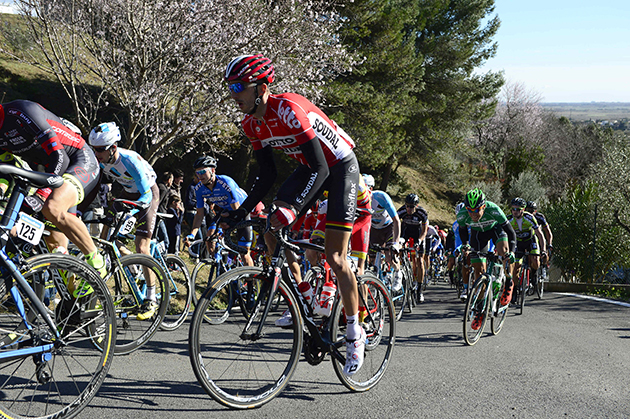
Jelle Vanendert will be there
Herman Frison: “If we get the same scenario as previous years, it will be a sprint with a large group on the Mur de Huy. We’ll do everything we can to avoid this, but it won’t be an easy task though. Riders such as Alejandro Valverde and Joaquim Rodríguez like it that the race ends with a sprint on the Mur de Huy, it’s a finish which suits them very well. But we can try to attack early with Tosh, Thomas or Tomasz so the other teams need to ride at the front of the peloton. In the finale we can count on Tim, Tony and Jelle. Hopefully several other riders from other teams are able to join us and then there are a lot of possibilities for us. The team already showed in the past few races that it can ride aggressively, I’m sure that we can do this again in the coming races.”
Line-up Lotto Soudal: Sander Armée, Bart De Clercq, Thomas De Gendt, Tony Gallopin, Tomasz Marczynski, Tosh Van der Sande, Jelle Vanendert and Tim Wellens.
Sports directors: Herman Frison and Bart Leysen.
Etixx-Quick Step will be there and here's their pre-race update:
Etixx-Quick Step will go into the penultimate Spring Classic with a balanced outfit, ready to play more cards.
Celebrating its 80th edition, Flèche Wallonne will depart from Marche-en-Femenne – a former medieval village located in the province of Luxembourg – for the first time in history, which will thus become the 12th town to host the start of the race. That's not the only change brought by the organizers, as this year's course, which is shorter than the one of last season, has a new climb introduced inside the final 43 kilometers, Côte de Solières, right before the second passing over the infamous Mur de Huy.
Later, Côte de Cherave will come on the route, providing the attackers with their only real opportunity to go from afar and foil the plans of the ones hoping to see the battle for victory unfold on the last ascent. Before the 1.3-km long hill which averages 9.6% there's going to be a fierce fight for position, as the favourites are aware that they must be at the front of the peloton when it will hit the maximum slope of 25%. Soon after, the famous S-bend will come, a well-timed attack on that explosive section being equivalent with taking the win atop Mur de Huy.
Julian Alaphilippe having at good day at the the 2015 Tour of California
Runner-up at the 2015 edition, Julian Alaphilippe returns at the start, where he'll be joined by Daniel Martin, who came on the podium two years ago, thus giving Etixx – Quick-Step more than one option on the final climb of the 196-km long race. Victorious in Brabantse Pijl last week, Petr Vakoč will be another important rider of the team, which will see also Gianluca Brambilla, David De La Cruz, Laurens De Plus, Bob Jungels and Pieter Serry line up at the start line in Marche-en-Femenne, on Wednesday.
Cannondale sent this Flèche Wallonne pre-race news:
The Cannondale Pro Cycling Team heads into the remaining Ardennes races with a balanced squad, aiming for strong results on the Mur de Huy and on the line at Liège-Bastogne-Liège.
Tom-Jelte Slagter remains the ace for the team due to his experience in the punchy classics, though Alex Howes, Lawson Craddock and Simon Clark are capable of doing some damage, too.
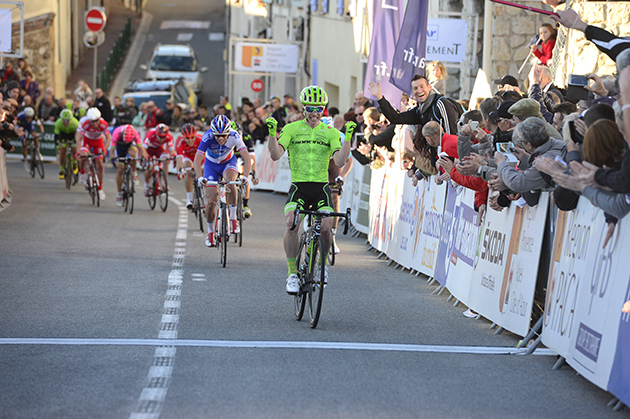
Tom Jelte Slagter wins at stage at this year's Haut Var
The parcours of Flèche and Liège are vastly different, though similar riders generally feature at the sharp end of both. Cannondale Pro Cycling Team is well suited to the terrain.
“I think the race has changed — it’s quite hard. It’ll be interesting for us,” sport director Johnny Weltz said. “We have a lot of young guns there. We just need to see how to get the best out of it.”
Howes is fresh off a nice ride in the all-day break at Amstel Gold Race where he was the last man standing from the escape and the best-placed finisher for Green Argyle while Craddock finished ninth in one of the season’s most brutal stage races, the Tour of the Basque Country. Slagter has keen awareness of these roads and winds.
“I like this area, specifically the climbs. I did these roads and climbs when I was younger for training and some races in juniors and u23s. I found out I liked these type of races the most. This is what I’m training for — to be good in these races. They’re WorldTour and important for the team,” Slagter said. “We have a good team here to do good results. The two are very different races. Both of very hard. Liège is a classic length, 260k, but if I look to Flèche, that finish climb, that suits me well.”
Weltz agrees. “If it turns out to be a lot of wind, he’ll have the benefit of knowing the better way to place himself,” the sport director said of Slagter. “On the other hand, the way Alex rides now, the way Craddock rides now, if we can get them to a safe place before the climbs they could do something, too.”
The Ardennes races are nervous affairs, often raced in inclement weather. It hailed during Amstel, and though the weather is clear for Flèche, that doesn’t mean it’s any walk in the park.
“It's a high speed game of chicken in every corner — it’s so nervous,” said Ben King. “It’s not a stage race. You can’t correct your mistake the next day.”
Howes looks to be recovered from his long break at Amstel in plenty of time for Liège, one of his better-liked races and the oldest of the major races on the calendar.
“Liege is like racing on old battle grounds. World War II tanks around. It’s a legitimate classic. It’s hard racing,” he said. “I think in a lot of ways it’s probably harder than Roubaix. … It’s a weird feeling. The motor’s been going so long it feels weird to turn the motor off, but at the same time you wanna be done so bad,” Howes said the sensations at the finish of the oldest one-day race on the calendar.
Cannondale Pro Cycling Team for La Flèche-Wallonne and Liège-Bastogne-Liège: Nathan Brown, Simon Clarke, Lawson Craddock, Alex Howes, Ben King, Toms Skujins, Tom-Jelte Slagter, Michael Woods
And finally, Orica-GreenEdge will be at La Flèche Wallonne. Here's their pre-race news:
Experienced Swiss rider Michael Albasini will lead ORICA-GreenEDGE at La Flèche-Wallonne on Wednesday after podium finishes here in 2012 and 2015.
The multiple Tour of Romandie stage winner came third last year and second in 2012 proving himself to be a consistent competitor in the Ardennes Classic.
A strong team of support will accompany Albasini including Paris-Nice stage winner Michael Matthews, Paris-Roubaix winner Mathew Hayman, 2015 Tour of Denmark Champion Chris Juul Jensen and Belgian classics specialist Jens Keukeleire.
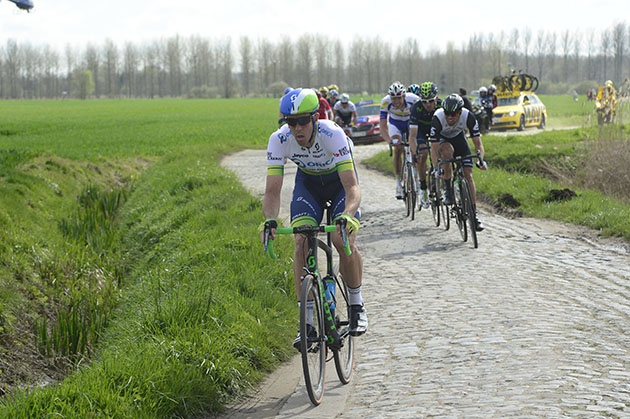
Mathew Hayman on his way to winning this year's Paris-Roubiax
The 80th edition of La Flèche-Wallonne takes place on Wednesday and is the second race of the trio of races that form the Ardennes Classics coming three days after Amstel Gold Race and four days before Liege-Bastogne-liege.
Sport director Matt White is confident that the team can perform well in the historic race. “We’ve done well here over the last few years,” said White. “Michael (Albasini) has repeatedly achieved good results here and he deserves to be our leader on Wednesday.”
“Michael works tirelessly for the team as we saw in Sunday’s Amstel Gold Race, he is giving his all for 90% of our races for others and this is where he gets his chance to be the protected rider.”
“We are going into the race with a strong team capable of performing well,” continued White. “It is always a hard race with an undulating parcours and one of the most challenging final kilometres of any race. We will be competitive and hopefully we can get Michael to where he needs to be to contest the finale.”
Experienced Canadian Christian Meier, San Sebastian winner Adam Yates and young Australian Jack Haig complete the line up for ORICA-GreenEDGE with the 22-year-old Haig making his debut in the race.
La Flèche-Wallonne is an iconic race that covers 196kilometres and is favoured by riders with a penchant for punchy climbs. The famous Mur de Huy is traversed three times throughout the race and is the point where many of the previous 80 instalments have been decided.
La Flèche-Wallonne takes place on Wednesday the 20th of April, the race will start in Marche-en-Famenne and finish in Huy.
ORICA-GreenEDGE at La Flèche-Wallonne (Wednesday 20th April): Michael Albasini, Jack Haig, Mathew Hayman, Chris Juul Jensen, Jens Keukeleire, Michael Matthews, Christian Meier, Adam Yates
Back to news and opinion index page for links to archived stories | Commentary







